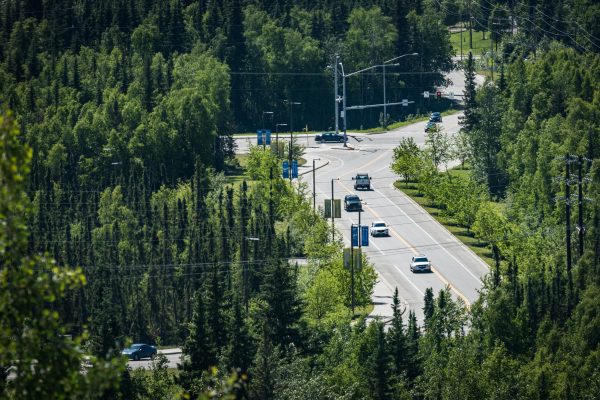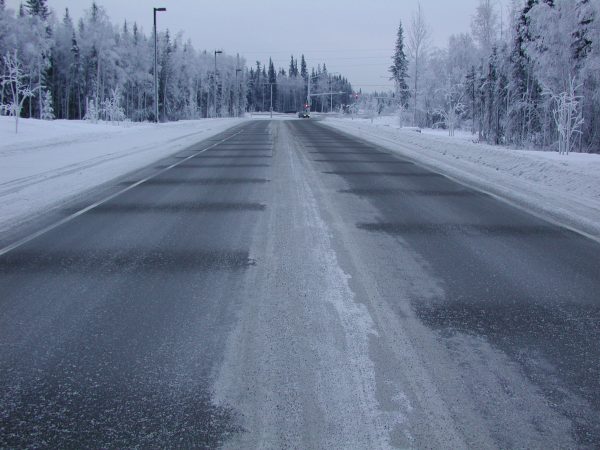UAF road project has become model for permafrost construction
August 8, 2017
Jeff Richardson
907-474-6284

Download text and photo captions here.
When planning began more than a decade ago for a new access road to the University of Alaska Fairbanks, it was clear that the high-profile job had a decent chance of turning into a fiasco.
The newly constructed Thompson Drive would introduce a strip of black asphalt across a layer of barely frozen ground. If the project caused the soil to warm by just a fraction of a degree, the permafrost beneath the road would begin to thaw, causing the pavement to sink and buckle.
Planners with the Alaska Department of Transportation had seen it happen before. The previous road that connected Geist Road to UAF had been abandoned because the thawing permafrost beneath it slumped, causing the road to fall away from a bridge that spans railroad tracks near campus.
When engineers designed the new access road to campus, they knew it needed to hold up better than the previous one.
“The last thing they wanted to do was repeat those problems all over again,” said Doug Goering, the dean of the UAF College of Engineering and Mines. “Mess with that permafrost at all and you’re talking about it thawing — that’s the problem with the Fairbanks area, is it’s all tenuous.”
With that in mind, UAF engineers and DOT road designers decided to take unprecedented measures to keep that permafrost frozen. Their experiment in road design has turned into a lasting success story, with some of its elements borrowed in projects throughout the Interior.

When its design began in 2001, the $16 million construction project incorporated several new techniques to keep permafrost frozen.
Much of Thompson Drive is built on a huge pile of coarse, grapefruit-sized rocks, which allows air to circulate beneath the roadway. The design, called an air-convection embankment, allows warm air to rise beneath the road bed and cool air to sink, super-cooling the permafrost in the winter time. The effect also helps cool the road’s shoulders, where an insulating layer of plowed snow would normally prevent deep winter cold from getting to the frozen ground.
Gas-filled tubes, called hairpin thermosyphons, were also buried horizontally beneath the asphalt surface. The refrigerant inside the hairpin-shaped hollow tubes evaporates in the lower portion of the tube during the winter, travels upward as a gas, condenses inside the upper, colder pipe and drops back down. The process sucks ground heat from beneath the roadway, which super-cools the permafrost throughout the winter. The effect can be seen in cold weather, when frost-free stripes form on the slightly warmer asphalt above the thermosyphons.
Goering and fellow UAF engineering colleagues John Zarling and Billy Connor suggested the design elements, which were incorporated by DOT designers. The combination was so untested, however, that the project qualified for funding through a U.S. Department of Transportation program for experimental building techniques.
Years later, the approach doesn’t seem so risky. Thompson Drive is remarkably smooth, at least by Fairbanks standards, and temperature readings of the permafrost beneath it show that the ground has actually cooled slightly since it was completed in 2004.
“In my mind, Thompson Drive is a documented success,” said Jeff Currey, the DOT Northern Region materials engineer. “I’d argue all the techniques there were successful.”

Some of them, particularly the use of rocky embankments, have been duplicated in road upgrades on the Elliott Highway and Taylor Highway. Last year, in a section of the Alaska Highway near Dot Lake, DOT successfully used the technique with polished river rock instead of jagged quarry stones.
Goering noted that innovative road-building approaches are needed now more than ever. Beneath Thompson Drive, the permafrost averages minus 0.2 degrees Celsius, just below the freezing point. Such “warm” permafrost across the Interior is particularly vulnerable as climate change delivers warmer temperatures.
Currey said expense will prevent some permafrost-preserving techniques from being used everywhere. But the once-experimental designs used in Thompson Drive are now almost conventional.
“A couple of methods used there have pretty much become tools in our toolbox when conditions are right and materials are available,” Currey said.


